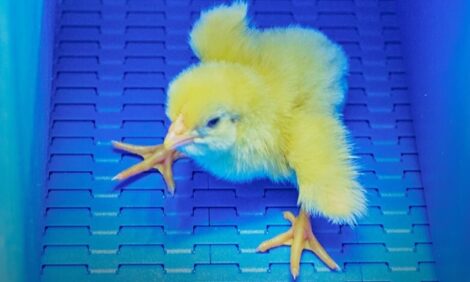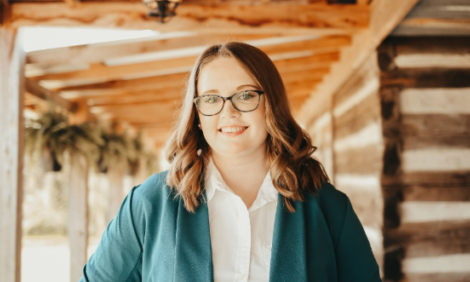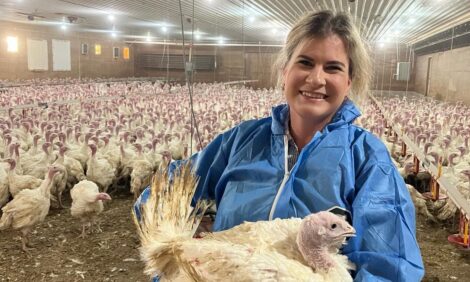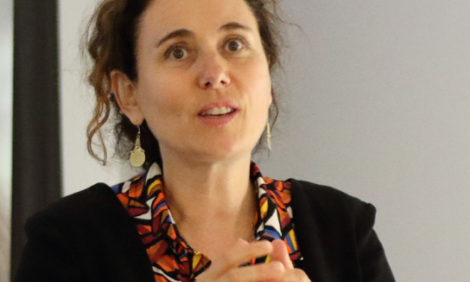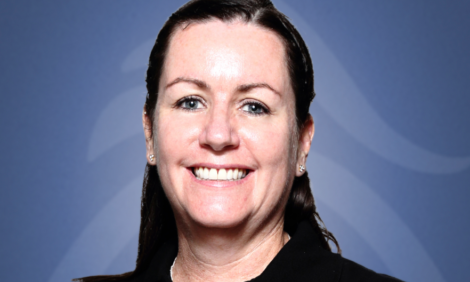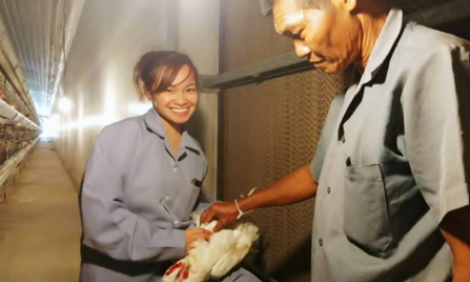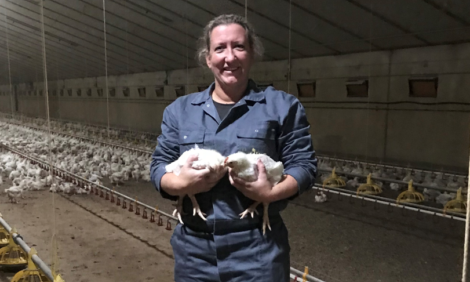



Women in Poultry: Mathilde Lecoupeur
Learn more about Mathilde Lecoupeur, Ceva Corporate Vaccination Services ManagerBased in France, Mathilde Lecoupeur is the Corporate Poultry Vaccination Services Manager for IB and IBD at Ceva. In her role, she drives the strategy worldwide and oversees field trials. Her focus; the best vaccine preparation and administration at the hatchery, to ensure healthy chicks and maximize flocks performance. Learn more about her background and her current role:
Please introduce yourself and describe your current role and responsibilities
I graduated from Agrocampus Ouest at Rennes, in Brittany; a French agronomic school where I’ve learned animal productions. Subsequently, I pursued a master’s in data analyse at the engineering school ENSAE, in Paris.
When I joined Ceva in March 2017, I took the position of Corporate Poultry Real World Evidence (RWE) manager. A strategic role aiming at revealing the added value of the data. Coming from our services (mainly serology data), but also from our customers' performance data (mortality percentage, feed conversation rate and so on).
Although Ceva has been collecting data for years, adding statistics vizualisations and tests for the business was new. I had to develop and lead a data cultural mindset. For our poultry producers, we have built a strong data service and brand-new successful activity: fact-based decisions in health program thanks to professional statistical analyses on multisources poultry data.
We are differentiating our products and services, showing with facts the cost of subclinical bronchitis disease. We are raising the bar of knowledge and expectation and switching the conversation from price to data insights. Over the last 2 years, veterinarians from Latin America, China and Asia have been trained.
For almost a year now, I have been holding the position of Corporate Poultry Vaccination Service and Equipment manager for both IB and IBD solutions. These vaccines are applied either by subcutaneous or spray route. I have been implementing a strategy and creating marketing contents for hatchery specialists for about 180 people located in more than 47 countries worldwide. My data experience helps connect between the immunization of the birds at the hatchery, and the performance obtained later at the farm and slaughterhouse levels. I also supervise field trials to demonstrate the added value of our vaccination equipment and propose some new data features for the future. At the end, connecting the vaccination quality together with the performance is what our customers are expecting from us.
I also dedicate time to other internal poultry projects, such as the quantification of the avian flu impact in Europe and in the USA, the creation of the - Poultry Health Solution Sustainability Calculator - showing the value of the usage of innovative poultry vaccines. By reducing the mortality percentage, our products, services and equipment help reduce the carbon footprint waste, feed more people and maximize the benefits. The three pillars of any sustainable activity. I’ve also participated as a volunteer to help a horse association during the Ceva Purpose Day in 2023. And I’m pleased to say that I’ve been a pioneer in the Handi’Chiens project launched at Ceva in 2018.
Describe a typical day in your current role?
There is not really a typical day in my current role and that’s what I like. I’m never in a routine mode.
I can be in business meetings defining the strategy for the next five years, or travelling for a week abroad, to share key information, make projects “go to market,” explain the specificities of our products and equipment, or visit customers.
I can also spend a day in France, at my desk, in front of my computer, remotely travelling worldwide. Moving from one meeting with China in the morning (French time), to another one with Brazil in the afternoon (French time).
I’m also working on marketing content and standard operating procedures (SOPs) with some local agencies. Deciding field trials to perform is part of my job as well. Proposing new developments to make in terms of people training, hatchery equipment and communication too. From time to time, I write articles for scientist publications or poultry magazines. I’ve been a poultry journalist for a year before joining Ceva.
To summarize: a typical day at Ceva is speaking English (if not a 3rd language) being polyvalent, travelling worldwide (in real or remotely) and adapting all the time.
What’s unique about your role?
Ceva is a French laboratory, owned by its people, with a global presence in more than 47 countries worldwide. Ceva is moreover a leader in the market of hatchery vaccination. With a complete and integrated offer: vaccines, equipment and services. With our own labs and campuses for research and development, my position is unique in so many aspects. I’m proud of it. It’s really enriching.
Leading remotely from France, I work with a network of hatchery experts with diverse backgrounds and their experience is huge. They also have different field challenges and cultures, so I must adapt all the time.
My objective is to train them, to develop their skills and keep their motivation at its maximum. Also, I carefully listen to any feedback to improve our current ways of working, our equipment and our tools. Maintaining a strong relationship between them is crucial. The network is priceless in our business. Learning from each other makes us win weeks, even months, if not years! Showing empathy and helping in the resolution of problems is also part of my role as well as challenging and making some tough decisions, when needed. At the end, people are expecting it from me.
What are the main challenges that you face in your role?
I’ve integrated a veterinarian lab without being a veterinarian myself. It was not easy at the beginning. Veterinarians are very technical people, so I’ve had to manage how to communicate with them and make my own place and to be recognized for my expertise.
It is inspiring with so many people located in so many different countries but it is also very challenging. They are all different in terms of background and age. Language can also be a barrier from time to time. That’s why I started to learn Portuguese after English, to develop the activity in Latin America and to be closer to be my colleagues from Brazil. But also, other countries like Peru, Colombia, Argentina and Mexico because people speaking Portuguese can understand Spanish. And since I’m not speaking with a strong accent nor at a high speed, they can easily understand my Portuguese too. That’s quite convenient!
What does the future of poultry health look like in terms of preventing and treating disease?
In past decades, all industries have greatly improved thanks to continuous measures of processes, performances and quality. This has produced more and more relevant information through valuable data, helping in our constant decision-making process. The poultry industry has also taken the same path, embracing the value of the data, from collecting the main production parameters (slaughter age, feed conversion rate, mortality percentage, etc.) to specific key performance indicators, following the health and growth of the birds, and the economic stability of the value chain.
Now, artificial intelligence (AI) is making noise; so, I believe the future of the poultry health will be under close computer supervision with cameras and captors everywhere. As well as alerts, predictive models and image reading/interpretation will also be used.
Are there individuals or organizations in poultry who you’ve found particularly inspirational?
A lot of my colleagues are inspiring me. They are 100% dedicated to their job, always ready to do a visit, meet a customer and train new veterinarians. it's as if they had started working for the poultry industry a few years ago, repeating again and again with the same energy and enthusiasm. That’s inspiring. They are also recognized worldwide, invited to many congresses and events. When people from overseas are asking for speeches from you and know your name, it means that you’re a good leader. And that you have mastered your subject. You inspire people; you unite them. Leaving a mark in a demanding and technical world is something I've found to be deeply inspiring.
Have you encountered any challenges as a woman in your field? If yes, how have you overcome them?
Yes, several. Jetlag, regular long flight trips, weeks out of home…the business world and its international perimeter explain partly why there are so few women. Politics is also at each corner; it can not be missed.
The credibility must come from results. From achievements. I worked very hard to demonstrate that people could rely on me. Give me big projects and offer me responsibilities. One key word to overcome challenges and make yourself a name in the business world: “deliver”.
Impacting and convincing both internally and externally also helped me a lot. Fortunately, I’m very curious, I love to learn new things and to improve myself, and I like to be out of my comfort zone. It would have honestly been very difficult otherwise.
What outstanding challenge facing the poultry industry would you most like to solve?
Welfare is by far the main challenge the poultry industry is facing. Contributing to solving at least part of it would be, for me, an achievement - at the hatchery, at the farm, during transportation and at slaughter. I believe improvements can be made at each stage of the poultry chain and would bring a lot. Some production changes have been made in Europe over the past few years, especially in layers, but I believe we could progress much more in different ways. Consumers are part of the equation. They are driving the industrials to produce specific products and follow certain criteria in terms of farm management. That’s why in 2018 I’ve worked to conclude a partnership between Ceva and the French Poultry Institute – Itavi – on their Ebene project. An application focusing on the bird’s behavior. The first of its kind.
What’s the most exciting innovation that you see on the horizon for the poultry industry?
Artificial intelligence (AI) brings a lot of potential exciting innovations. The capability to prevent disease remains the most important one, for the sustainability of industry, and humanity. We saw the impact of the avian influenza. It can quickly become a vicious circle with prices rising, and people not catching up to follow the crisis. Reducing their meat consumption. Some researchers are working on the bird songs to detect some coughing and prevent high mortality percentages. Today, because of the short life-circle of the flocks at 35 days and the high number of birds in a single building, it’s complex to act during the growth of the birds. Usually, we learn from the previous flocks to prevent any disease for the next ones to come. An individual and immediate treatment for the birds affected would be a great innovation to come. To save resources in terms of energy, food, water and meat.
What would be your advice to young female veterinarians entering the profession around poultry?
Well, I’m not a vet, and I managed to find a place. The poultry industry is welcoming, but you will need to show dedication (be ready to do extra hours in the field, visit hatcheries at 4 am), show integrity, credibility and have empathy. Being curious is also very important to ask questions and learn faster. But before all: deliver results.
Also, you should consider two types of vets: the ones in the field, and the ones working for laboratories like I do. It’s not the same kind of work.
The first one is closest to the animals, the farmers and their technicians. Whereas the second one is more business and marketing related and giving talks on major poultry events or symposiums and publications. Showing the added value of vaccines and supporting the poultry industry worldwide. Always offering better products, equipment and services.
What’s your next challenge?
My current challenge is to develop new indicators at the hatchery; to show the link between protection – therefore vaccine administration – and performance at farm and slaughterhouse level. Because even the best vaccine, if not well administrated, won’t protect birds and secure their growth, therefore the business. Too often, the hatchery is not considered enough. That’s because the value of the product grows with time. Once you have fed the birds, which represent 70% of the production costs, then their value goes up. People are usually focusing on the farm management practices only, and/or the vaccination program. But they are not paying enough attention to the hatchery vaccine administration or to the hatchery machines.







